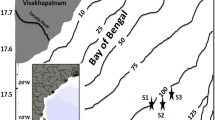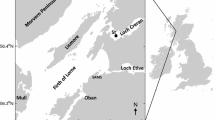Summary
The depth distribution and composition of residual amino acids was determined in December 1980 in the Bransfield Strait. The major components were aspartic and glutamic acids together with alanine, glycine and serine. Non-protein amino acids were not found in significant amounts. On the average, the amino acids accounted for 25% of the total organic carbon and 50% of the organic nitrogen. Amino acid nitrogen/chlorophyll ratios indicated that in most euphotic zone samples phytoplankton in good physiological condition was present whereas heavily degraded material was found in deeper water layers. Statistical treatment and cluster analysis show distinct differences between euphotic and aphotic zone samples which could be used to characterize phytoplankton communities.
Similar content being viewed by others
References
Bodungen von V, Smetacek VS, Tilzer MM, Zeitzschel B (in press) Primary production and sedimentation during austral spring in the Antarctic Peninsula region. Deep-Sea Res
Bölter M, Dawson R (1982) Heterotrophic utilisation of biochemical compounds in Antarctic waters. Neth J Sea Res 16:315–332
Bölter M, Meyer M (1983) The sandy beach area of Kiel Fjord and Kiel Bight (Western Baltic Sea) — A structural analysis of a shallow water ecosystem. In: McLachlan A, Erasmus T (eds) Sandy beaches as ecosystems. Junk, The Hague, pp 263–270
Bölter M, Meyer M, Probst B (1980) A statistical scheme for structural analysis in marine ecosystems. Ecol Modell 9:143–151
Chau YK, Chuecas R, Riley JP (1967) The component combined amino acids of some marine phytoplankton species. J Mar Biol Assoc UK 47:543–554
Cowey CB, Corner EDS (1963) On the nutrition and metabolism of zooplankton. 2. The relationship between the marine copepod Calanus helgolandicus and particulate material in Plymouth sea water, in terms of amino acid composition. J Mar Biol Assoc UK 43:495–511
Cowey CB, Corner EDS (1966) The amino-acid composition of certain unicellular algae, and the faecal pellets produced by Calanus finmarchicus when feeding on them. In: Barnes H (ed) Some contemporary studies in marine science. Allen and Unwin, London, pp 225–231
Dawson R, Liebezeit G (1983) Determination of amino acids and carbohydrates. In: Grasshoff K, Kremling K, Ehrhardt M (eds) Methods of seawater analysis, 2nd edn. Verlag Chemie, Weinheim (FRG), pp 319–340
Degens ET (1970) Molecular nature of nitrogenous compounds in seawater and recent marine sediments. In: Hood DW (ed) Organic matter in natural waters. University of Alaska, Occ Publ 1, pp 77–106
Degens ET, Mopper K (1976) Factors controlling the distribution and early diagenesis of organic material in marine sediments. In: Riley JP, Chester R (eds) Chemical oceanography, vol 6, 2nd edn. Academic Press, London, pp 60–113
French FW, Hargraves PE (1980) Physiological characteristics of plankton diatom resting spores. Mar Biol Lett 1:185–195
Haardt H, Maaßen R (1983) CTD and optical data from the Antarctic-Meteor 56 Ant I-Part I: CTD and chlorophyll profiles. Rep Sonderforschungsber 95, University of Kiel 57, pp 1–183
Hecky RE, Mopper K, Kilham P, Degens ET (1973) The amino acid and sugar composition of diatom cell-walls. Mar Biol 19:323–331
Jukes TH, Holmquist R, Moise H (1975) Amino acid composition of proteins: selection against the genetic code. Science 189:50–51
Lampert W (1978) Release of dissolved organic carbon by grazing zooplankton. Limnol Oceanogr 23:831–834
Lee C, Cronin C (1982) The vertical flux of particulate organic nitrogen in the sea: decomposition of amino acids in the Peru Upwelling area and the equatorial Atlantic. J Mar Res 40:227–251
Lee C, Cronin C (1984) Particulate amino acids in the sea: Effects of primary productivity and biological decomposition. J Mar Res 42:1075–1097
Liebezeit G (1984) Particulate carbohydrates in relation to phytoplankton in the euphotic zone of the Bransfield Strait. Polar Biol 2:225–228
Liebezeit G (1985) Residual amino acid fluxes in the upper water column of the Bransfield Strait. Oceanol Acta 8:59–65
Liebezeit G, Schumann M, Bohde F (1985) Residual amino acid fluxes in Kiel Bight-February to June 1980. Mar Ecol Prog Ser 27:203–207
Lindroth P, Mopper K (1979) High performance liquid chromatographic determination of subpicomole amounts of amino acids by precolumn fluorescence derivatization with o-phthaldialdehyde. Anal Chem 51:1667–1674
Packard TT, Dortch Q (1975) Particulate protein-nitrogen in North Atlantic surface waters. Mar Biol 33:347–354
Parsons TR, Stephens K, Strickland JDH (1961) On the chemical composition of eleven species of marine phytoplankters. J Fish Res Board Can 18:1001–1015
Schanck SB, Smetacek VS, Bodungen B von, Stegmann P (1984) Utilization of phytoplankton by copepods in Antarctic waters during spring. In: Gray JS, Christiansen E (eds) Marine biology of polar regions and effects of stress on marine organisms. Wiley and Sons, Chichester, pp 65–81
Schumann M (1983) Die Zusammensetzung partikulären organischen Materials aus der Kieler Bucht und dessen Verwertung durch Mytilus edulis. Dissertation Universität Kiel, 155 pp
Siezen RJ, Mague TH (1978) Amino acids in suspended particulate matter from oceanic and coastal waters of the Pacific. Mar Chem 6:215–231
Sigleo AC, Hare PE, Helz GR (1983) The amino acid composition of estuarine colloidal material. Estuarine Coast Shelf Sci 17:87–96
Suzuki Y, Sugimura Y, Itoh T (1985) A catalytic oxidation method for the determination of total nitrogen dissolved in seawater. Mar Chem 16:83–97
Tanoue E, Handa N, Sakugawa H (1982a) Difference of the chemical composition of organic matter between fecal pellet of Euphausia superba and its feed, Dunaliella tertiolecta. Trans Tokyo Univ Fish 5:189–196
Tanoue E, Handa N, Kato M (1982b) Horizontal and vertical distribution of particulate organic matter in the Pacific sector of the Antarctic Ocean. Trans Tokyo Univ Fish 5:65–83
Tilzer M, Bodungen B von (1981) Produktivität des Phytoplanktons. In: Zeitzschel B, Zenk W (eds) Beobachtungen und erste Ergebnisse der Meteor-Reise 56 aus der Scotia-See und der Bransfield-Straße im November/Dezember 1980 (ANTI): ein nautischer und wissenschaftilicher Bericht. Ber Inst Meeresk Kiel 80, pp 48–53
UNESCO (1966) Determination of photosynthetic pigments in sea water. Monogr Oceanogr Methodol 1:1–66
Wefer G, Suess E, Balzer W, Liebezeit G, Müller PJ, Ungerer CA, Zenk W (1982) Fluxes of biogenic compounds from sediment trap deployment in circumpolar waters of the Drake Passage. Nature 299:145–147
Author information
Authors and Affiliations
Rights and permissions
About this article
Cite this article
Liebezeit, G., Bölter, M. Distribution of particulate amino acids in the Bransfield Strait. Polar Biol 5, 199–206 (1986). https://doi.org/10.1007/BF00446087
Received:
Accepted:
Issue Date:
DOI: https://doi.org/10.1007/BF00446087




